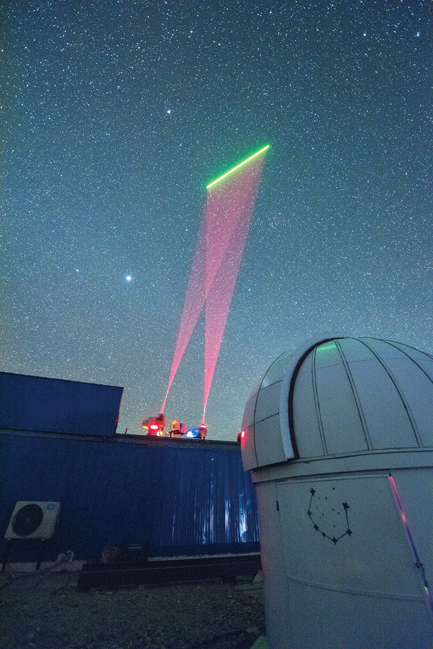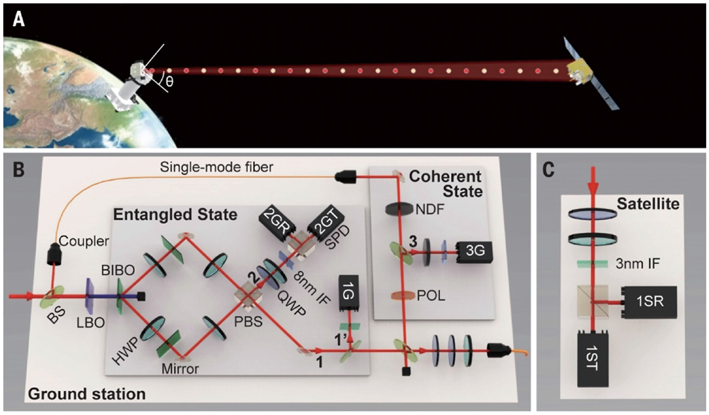By SONG Jianlan (Staff Reporter)
“Our measurement results are consistent with the standard quantum theory and hence do not support the prediction of event formalism.”
– Micius Team

When passing the ground station at different altitude angles, entangled photons distributed by Micius intercepts different regions of the Earth’s gravitational field, and hence undergoes fluctuation of the potential field.
An experiment performed by Micius, a satellite for quantum physics experiments flying at an altitude of about 500 km above the Earth, verifies that the entangled quantum pairs survived the effect of the Earth’s gravity, when distributed across the latter in space. With ultra-high precision, this experiment disapproves a prediction given by the “event formalism” of quantum fields, an “ultimate theory” model trying to describe quantum fields across different spacetimes, including the classic ordinary spacetime and “exotic” ones that contain closed time-like curves. This announces once more failure of human’s efforts to unify quantum mechanics and general relativity, the two “pillars” that has been supporting modern physics.
Bridging Two Kingdoms
For about 90 years, physicists have sought to unify the two – they each have been very successful in explaining how the macroscopic and microscopic universes work, yet have great difficulties once applied to the other’s realm. Their unification is particularly important for research into some extreme scenarios, for example the inner spacetime of a black hole. Currently, the two are in odds with each other in such extreme situations. If this unification is successful, all of the four fundamental forces in nature – the gravitational force, the electromagnetic force, the strong nuclear action, and the weak nuclear action – will be described in a uniform formulation, given that the latter three have been actually integrated in the Standard Model, which describes the quantum world.
As efforts to bridge gravity and quantum fields, many rival models of quantum gravity have arisen, but mostly provide little foundation for experimental test – their verification demands extremely stern experimental conditions. “Some tests need to be taken under a spatial dimension as small as 10-35 meter, 20 orders smaller than the diameter of an electron; while some others occur only at energy ranges as high as 1019GeV, 15 orders larger than the highest energy of the Large Hadron Collider, the most powerful particle accelerator human beings have ever built, can produce,” says Prof. PAN Jianwei, Member of the Chinese Academy of Sciences (CAS) and principal investigator of the Micius experiment. “We do not see any chance to achieve such extreme experimental conditions in labs even in future several decades,” he adds.
Unlike other models, the “event formalism” of quantum fields, when attempting to give a coherent description of quantum fields applicable across ordinary spacetime and “exotic” spacetimes, makes some predictions that are possible for scientists to test in the gravitational fields of planets, for example our home Earth.
Examining Quantum Entanglement in Gravity
According to event formalism model, in an ordinary spacetime, quanta behave as what quantum mechanics describes; whilst in an exotic spacetime containing closed timelike curves, decoherence will happen to the entangled quanta. When it comes to a warped spacetime containing no closed timelike curve – for example the one we live in, where the gravity of the Earth bends the spacetime – the model predicts that a pair of time-energy entangled particles would decorrelate at some probability, when passing through different regions of the gravitational potential of the Earth, resulting from the latter’s gravity field. The last prediction listed above can be verified in the space surrounding the Earth – if the experiment is performed at a good-enough accuracy.
Micius, launched in August 2016 to a sun-synchronous orbit about 500 km above sea level, offers an excellent quantum optical laboratory to test this prediction. It is capable of distributing quantum entanglement states across a distance over 1,400 km at an extremely high fidelity: when sending photons from the transmitter antenna at the ground station situated in Ngari of Tibet, China, the average signal loss throughout the free space optical link can be controlled to less than 50 dB at its working wavelengths.
In their experiment, the team led by Prof. PAN Jianwei from the University of Science and Technology of China (USTC) generated entangled photon pairs at the ground station in Ngari, and separated the twins: one of them was sent to the satellite, and the other remained at the station. While the satellite passed the ground station at different altitude angles (varying from 40 to 60 degrees) at different nights, they examined the time-correlation between the two photons. For comparison, they also recorded two-photon coincidence events with pulsed coherent laser light source in the same setting. When passing the station at different altitude angles, the link between the entangled pair intercepted different regions of the space, exposing the quantum state to fluctuations of the gravity field.

Schematics of the experimental test of the prediction given by the “event formalism” model in Earth’s gravitational field.
Further Investigation Expected
According to the “event formalism” model, the decorrelation would happen at different probabilities, dependent on the altitude angle. This predicted decoherence, however, did not happen to the entangled quantum pairs intercepting the space across the large distance between the Earth ground and Micius’ orbit. “Our measurement results are consistent with the standard quantum theory and hence do not support the prediction of event formalism,” the team report in their paper published on 4 October in Science.
The physical community had stopped short of testing this prediction before, due to the demanding precision posed by the challenge – the gravity field of the Earth is so weak that it far surpasses the limit of classic equipment. Scientists had pinned their hope on data from cosmological observations and particle physics experiments, yet the situation did not change until Micius came to make its attempt.
Now the two worlds remain isolated. However, the team reserve some caution when interpreting their victory. “This does not necessarily rule out other approaches,” they say, allowing some room for other theories. On the other hand, they speculate that when testing with a different reference framework of time, the scale of the predicted decoherence effect might be weaker. To test this weaker effect with sufficient statistical confidence, however, requires the satellite to make so many more passes that it would be impossible for Micius to complete the experiment within its lifetime. Therefore, they would leave this to a future experiment. Aside from improving the temporal resolution hence presenting a conclusive experimental verification of the decoherence effects, the team expect, the future experiment might also offer more insightful knowledge about a number of interesting gravity-related models, not limited to the “event formalism”.
As for the “event formalism” itself, PAN says, the team would launch a new satellite to a higher orbit – 20 to 60 times higher than the current one – to test the model to a higher interaction order and at a better precision.
References
Sheng-Kai Liao, Wen-Qi Cai, Wei-Yue Liu, Liang Zhang, Yang Li, Ji-Gang Ren, Juan Yin, Qi Shen, Yuan Cao, Zheng-Ping Li, Feng-Zhi Li, Xia-Wei Chen, Li-Hua Sun, Jian-Jun Jia, Jin-Cai Wu, Xiao-Jun Jiang, Jian-Feng Wang, Yong-Mei Huang, Qiang Wang, Yi-Lin Zhou, Lei Deng, Tao Xi, Lu Ma, Tai Hu, Qiang Zhang, Yu-Ao Chen, Nai-Le Liu, Xiang-Bin Wang, Zhen-Cai Zhu, Chao-Yang Lu, Rong Shu, Cheng-Zhi Peng*, Jian-Yu Wang* & Jian-Wei Pan*. (2017) Satellite-to-ground quantum key distribution. Nature 549, 43–47.
Ji-Gang Ren, Ping Xu, Hai-Lin Yong, Liang Zhang, Sheng-Kai Liao, Juan Yin, Wei-Yue Liu, Wen-Qi Cai, Meng Yang, Li Li, Kui-Xing Yang, Xuan Han, Yong-Qiang Yao, Ji Li, Hai-Yan Wu, Song Wan, Lei Liu, Ding-Quan Liu, Yao-Wu Kuang, Zhi-Ping He, Peng Shang, Cheng Guo, Ru-Hua Zheng, Kai Tian, Zhen-Cai Zhu, Nai-Le Liu, Chao-Yang Lu, Rong Shu, Yu-Ao Chen, Cheng-Zhi Peng*, Jian-Yu Wang* & Jian-Wei Pan*. (2017) Ground-to-satellite quantum teleportation. Nature 549, 70–73.
Sheng-Kai Liao, Hai-Lin Yong, Chang Liu, Guo-Liang Shentu, Dong-Dong Li, Jin Lin, Hui Dai, Shuang-Qiang Zhao, Bo Li, Jian-Yu Guan, Wei Chen, Yun-Hong Gong, Yang Li, Ze-Hong Lin, Ge-Sheng Pan, Jason S. Pelc, M. M. Fejer, Wen-Zhuo Zhang, Wei-Yue Liu, Juan Yin, Ji-Gang Ren, Xiang-Bin Wang, Qiang Zhang*, Cheng-Zhi Peng* & Jian-Wei Pan*. (2017) Long-distance free-space quantum key distribution in daylight towards inter-satellite communication, Nature Photonics 11, 509–513.
Ping Xu, Yiqiu Ma, Ji-Gang Ren, Hai-Lin Yong, Timothy C. Ralph, Sheng-Kai Liao, Juan Yin, Wei- Yue Liu, Wen-Qi Cai, Xuan Han, Hui-Nan Wu, Wei-Yang Wang, Feng-Zhi Li, Meng Yang, Feng-Li Lin, Li Li, Nai-Le Liu, Yu-Ao Chen, Chao-Yang Lu, Yanbei Chen, Jingyun Fan*, Cheng-Zhi Peng*, Jian-Wei Pan*. (2019) Satellite testing of a gravitationally induced quantum decoherence model. Science. (Doi: 10.1126/science.aay5820)

